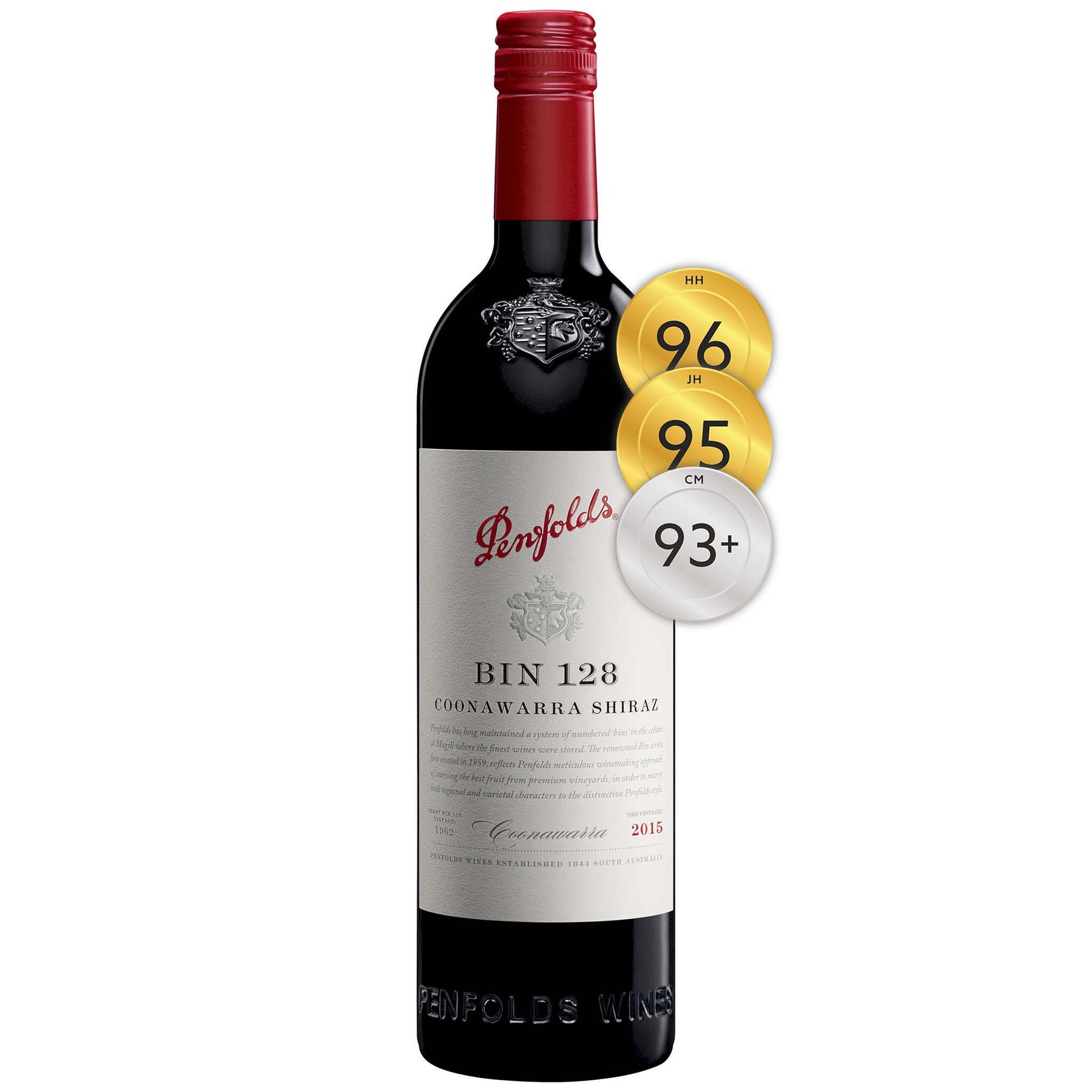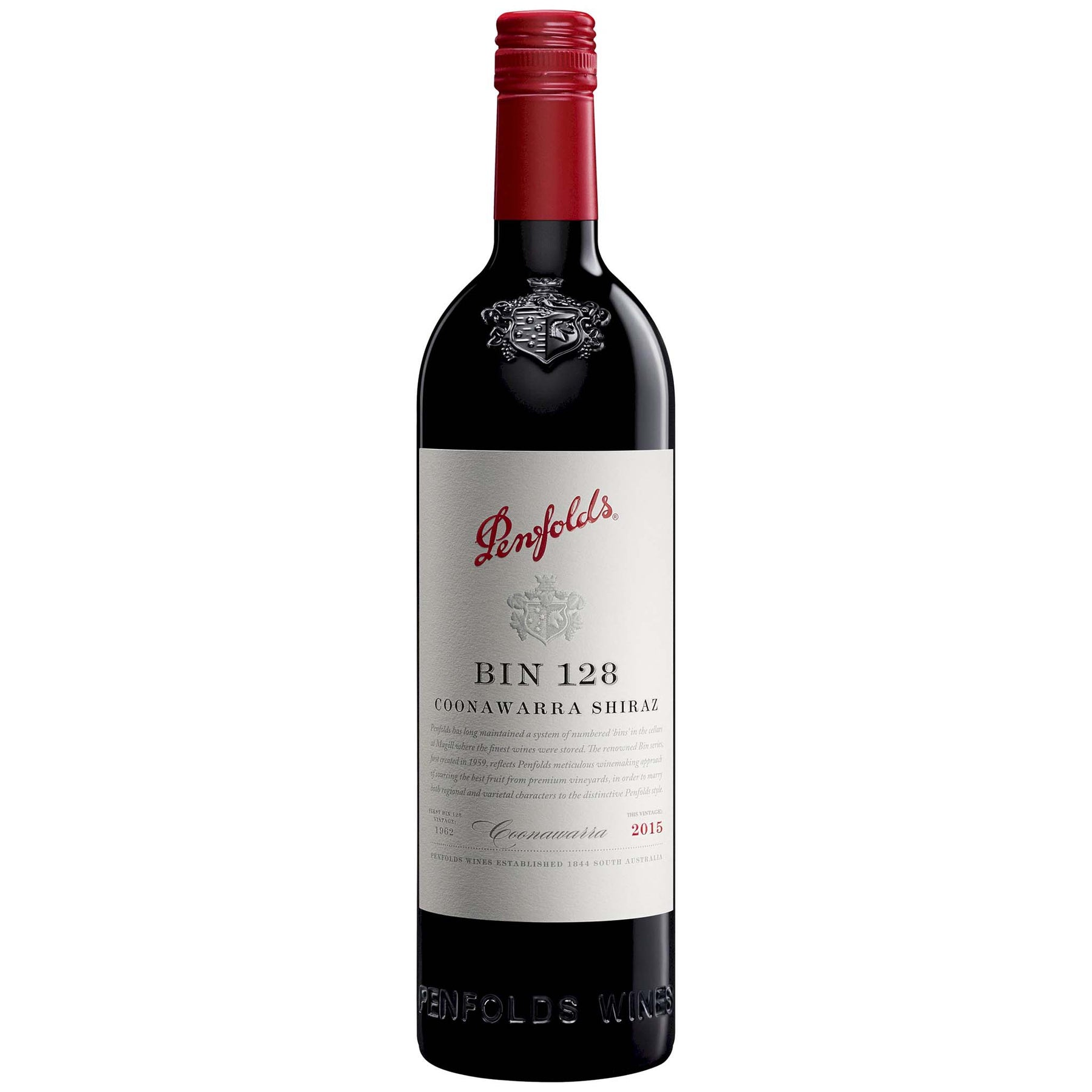

Penfolds Bin 128 Coonawarra Shiraz 2015
Style: Red Wine
Variety: Shiraz
Closure: Screwcap
Penfolds Bin 128 Coonawarra Shiraz 2015
Warehouse
34 Redland Drive
Vermont VIC 3133
Australia
Critic Score: 96
Alcohol: 14.5%
Size: 750 ml
Drink by: 2035
Penfolds Bin 128 is sourced from the unique terra rossa soils of Coonawarra, a region that exemplifies the perfume, transparency and seductive nature of cool climate red table wines. Coonawarra has remained the sole source of shiraz fruit for Bin 128 since the inaugural release of the 1962 vintage. In order to further enhance the regional qualities of Bin 128, the wine is matured in a mixture of new and seasoned French oak hogsheads, a method that was refined during the 1980's when the transition was made from American to French oak. The cool climate Bin 128 Coonawarra Shiraz provides an interesting counterpoint to the more opulent and richly concentrated warm climate Bin 28 Shiraz.
"The wine has a lovely silky texture and suppleness, and is deep and intense, bright and fresh but not a simple fruit-wine. There's a higher level of character. Oak is very background here. A stand-out Bin 128." Huon Hooke
The 2015 Bin 128 Kalimna was matured for 12 months in French oak hogsheads (30% new, 30% 1-y.o., 40% 2-y.o.).
"Medium-deep crimson. Ripe raspberry, cranberry and cassis aromas with vanilla and a hint of fennel. Generous and supple with cranberry, cassis and chocolate-coated liquorice flavours, fine and plentiful chalky tannins and underlying savoury oak. Finishes al dente firm and minerally. Has a seductive allure with zippy freshness. Drink now to 2035.
Vintage Conditions: Above-average temperatures were recorded in winter and continued throughout spring. Rainfall was below average throughout winter, due to a drier August, and dry conditions persisted through spring resulting in early vine growth. The summer period saw rainfall over 10mm higher than the long-term average due to a high rainfall event occurring in January, preveraison. Moderate temperatures from early summer through to vintage meant that ripening was steady with the Coonawarra recording ten days over 35 degrees during the summer period." Penfolds
Expert reviews
"Very bright, youthful, deep purple/red colour, with a lovely fragrant nose, floral and spicy, and almost a hint of whole-bunch (but there was none). The wine has a lovely silky texture and suppleness, and is deep and intense, bright and fresh but not a simple fruit-wine. There's a higher level of character. Oak is very background here. A stand-out Bin 128. (30% new oak hogsheads). Drink: 2017-2047." Huon Hooke, The Real Review - 96 points
"Matured for 12 months in French hogsheads (30% new). Very good depth and hue; the bouquet immediately bursts into vinous song from the first whiff, with fragrant red fruits to the fore; the palate wastes no time in adding darker fruits and substantial tannins to the mix. This demands time and will be very long lived, with the balance to richly repay patience. Drink by: 2040." James Halliday, Halliday Wine Companion - 95 points
"Sweet coconut, raspberry, chocolate and spice. This is a particularly exuberant Bin 128; it has its doll face on. It has quite a deal of tannin too, not wrenching or grippy but certainly there, and in any case this tannin comes soaked in flavour; it's one of the more 'complete' Bin 128s I've seen. Yes it will age for as long as you'd like but boy it's a joyous red right now. Expressive is the word. Oak makes a steady/heady contribution but the fruit here is lovely." Campbell Mattinson, The Wine Front - 93+ points
After the success of early sherries and fortified wines, founders Dr Christopher and Mary Penfold planted the vine cuttings they had carried on their voyage over to Australia. In 1844 the fledging vineyard was officially established as the Penfolds wine company at Magill Estate.
As the company grew, so too did Dr Penfold's medical reputation, leaving much of the running of the winery to Mary Penfold. Early forays into Clarets and Rieslings proved increasingly popular, and on Christopher's death in 1870, Mary assumed total responsibility for the winery. Mary's reign at the helm of Penfolds saw years of determination and endeavour.
By the time Mary Penfold retired in 1884 (ceding management to her daughter, Georgina) Penfolds was producing 1/3 of all South Australia's wine. She'd set an agenda that continues today, experimenting with new methods in wine production. By Mary's death in 1896, the Penfolds legacy was well on its way to fruition. By 1907, Penfolds had become South Australia's largest winery.
In 1948, history was made again as Max Schubert became the company's first Chief Winemaker. A loyal company man and true innovator, Schubert would propel Penfolds onto the global stage with his experimentation of long-lasting wines - the creation of Penfolds Grange in the 1950s.
In 1959 (while Schubert was perfecting his Grange experiment in secret), the tradition of ‘bin wines' began. The first, a Shiraz wine with the grapes of the company's own Barossa Valley vineyards was simply named after the storage area of the cellars where it is aged. And so Kalimna Bin 28 becomes the first official Penfolds Bin number wine.
In 1960, the Penfolds board instructed Max Schubert to officially re-start production on Grange. His determination and the quality of the aged wine had won them over.
Soon, the medals began flowing and Grange quickly became one of the most revered wines around the world. In 1988 Schubert was named Decanter Magazine's Man of the Year, and on the 50th anniversary of its birth, Penfolds Grange was given a heritage listing in South Australia.
Despite great success, Penfolds never rests on its laurels. In 2012 Penfolds released its most innovative project to date - 12 handcrafted ampoules of the rare 2004 Kalimna Block Cabernet Sauvignon.
Two years later, Penfolds celebrated the 170th anniversary – having just picked up a perfect score of 100 for the 2008 Grange in two of the world's most influential wine magazines. Today, Penfolds continues to hold dear the philosophies and legends – '1844 to evermore!'.

South Australia
South Australian is responsible for more than half the production of all Australian wine. It is home to more than 900 wineries across 18 wine regions. The regions are Adelaide Hills, Adelaide Plains, Barossa Valley, Clare Valley, Coonawarra, Currency Creek, Eden Valley, Kangaroo Island, Langhorne Creek, McLaren Vale, Mount Benson, Mount Gambier, Padthaway, Riverland, Robe, Southern Fleurieu, Southern Flinders Ranges and Wrattonbully.
Many of the well-known names in the South Australian wine industry established their first vineyards in the late 1830s and early 1840s. The first vines in McLaren Vale were planted at Reynella in 1839 and Penfold's established Magill Estate on the outskirts of Adelaide in 1844.
South Australia has a vast diversity in geography and climate which allows the State to be able to produce a range of grape varieties - from cool climate Riesling in the Clare and Eden Vallies to the big, full bodied Shiraz wines of the Barossa Valley and McLaren Vale. Two of Australia's best-known wines, Penfolds Grange and Henschke Hill of Grace, are produced here. There is much to discover in South Australia for the wine lover.


